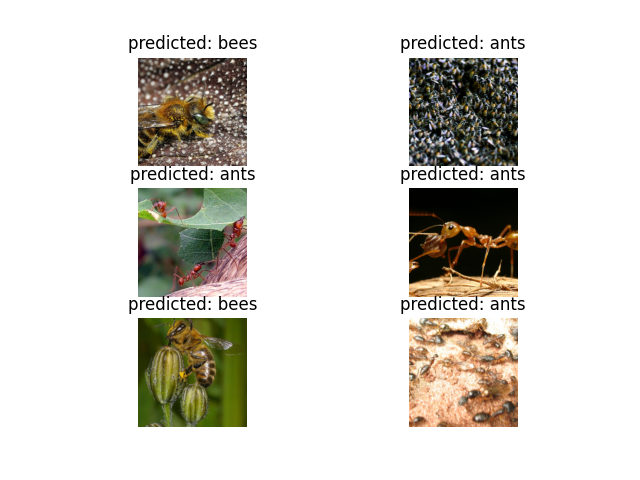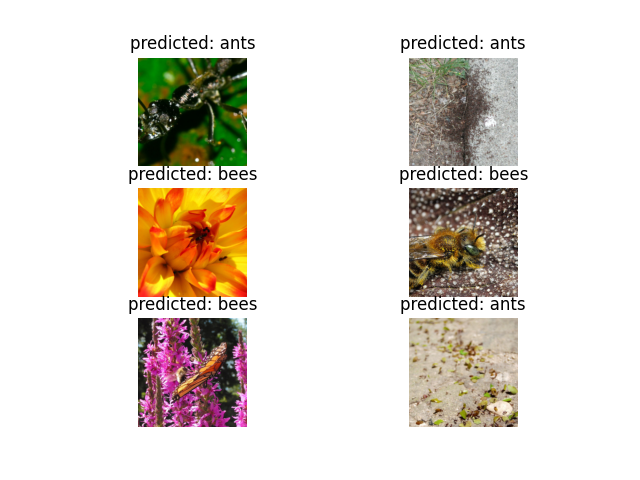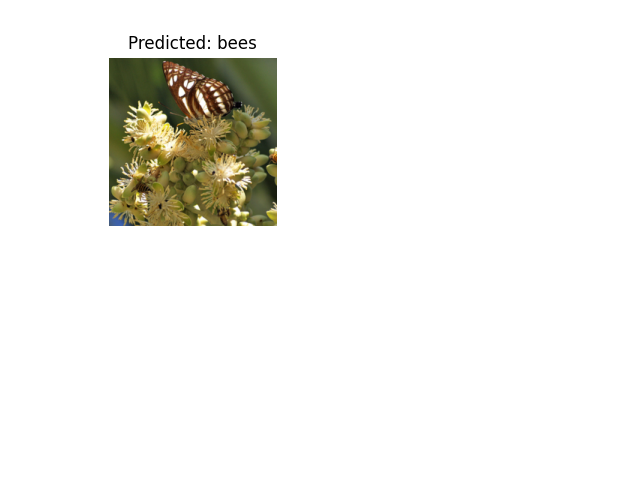


Note
Go to the end to download the full example code.
Transfer Learning for Computer Vision Tutorial#
Created On: Mar 24, 2017 | Last Updated: Jan 27, 2025 | Last Verified: Nov 05, 2024
Author: Sasank Chilamkurthy
In this tutorial, you will learn how to train a convolutional neural network for image classification using transfer learning. You can read more about the transfer learning at cs231n notes
Quoting these notes,
In practice, very few people train an entire Convolutional Network from scratch (with random initialization), because it is relatively rare to have a dataset of sufficient size. Instead, it is common to pretrain a ConvNet on a very large dataset (e.g. ImageNet, which contains 1.2 million images with 1000 categories), and then use the ConvNet either as an initialization or a fixed feature extractor for the task of interest.
These two major transfer learning scenarios look as follows:
Finetuning the ConvNet: Instead of random initialization, we initialize the network with a pretrained network, like the one that is trained on imagenet 1000 dataset. Rest of the training looks as usual.
ConvNet as fixed feature extractor: Here, we will freeze the weights for all of the network except that of the final fully connected layer. This last fully connected layer is replaced with a new one with random weights and only this layer is trained.
# License: BSD
# Author: Sasank Chilamkurthy
import torch
import torch.nn as nn
import torch.optim as optim
from torch.optim import lr_scheduler
import torch.backends.cudnn as cudnn
import numpy as np
import torchvision
from torchvision import datasets, models, transforms
import matplotlib.pyplot as plt
import time
import os
from PIL import Image
from tempfile import TemporaryDirectory
cudnn.benchmark = True
plt.ion() # interactive mode
<contextlib.ExitStack object at 0x7f1d122a4760>
Load Data#
We will use torchvision and torch.utils.data packages for loading the data.
The problem we’re going to solve today is to train a model to classify ants and bees. We have about 120 training images each for ants and bees. There are 75 validation images for each class. Usually, this is a very small dataset to generalize upon, if trained from scratch. Since we are using transfer learning, we should be able to generalize reasonably well.
This dataset is a very small subset of imagenet.
Note
Download the data from here and extract it to the current directory.
# Data augmentation and normalization for training
# Just normalization for validation
data_transforms = {
'train': transforms.Compose([
transforms.RandomResizedCrop(224),
transforms.RandomHorizontalFlip(),
transforms.ToTensor(),
transforms.Normalize([0.485, 0.456, 0.406], [0.229, 0.224, 0.225])
]),
'val': transforms.Compose([
transforms.Resize(256),
transforms.CenterCrop(224),
transforms.ToTensor(),
transforms.Normalize([0.485, 0.456, 0.406], [0.229, 0.224, 0.225])
]),
}
data_dir = 'data/hymenoptera_data'
image_datasets = {x: datasets.ImageFolder(os.path.join(data_dir, x),
data_transforms[x])
for x in ['train', 'val']}
dataloaders = {x: torch.utils.data.DataLoader(image_datasets[x], batch_size=4,
shuffle=True, num_workers=4)
for x in ['train', 'val']}
dataset_sizes = {x: len(image_datasets[x]) for x in ['train', 'val']}
class_names = image_datasets['train'].classes
# We want to be able to train our model on an `accelerator <https://pytorch.org/docs/stable/torch.html#accelerators>`__
# such as CUDA, MPS, MTIA, or XPU. If the current accelerator is available, we will use it. Otherwise, we use the CPU.
device = torch.accelerator.current_accelerator().type if torch.accelerator.is_available() else "cpu"
print(f"Using {device} device")
Using cuda device
Visualize a few images#
Let’s visualize a few training images so as to understand the data augmentations.
def imshow(inp, title=None):
"""Display image for Tensor."""
inp = inp.numpy().transpose((1, 2, 0))
mean = np.array([0.485, 0.456, 0.406])
std = np.array([0.229, 0.224, 0.225])
inp = std * inp + mean
inp = np.clip(inp, 0, 1)
plt.imshow(inp)
if title is not None:
plt.title(title)
plt.pause(0.001) # pause a bit so that plots are updated
# Get a batch of training data
inputs, classes = next(iter(dataloaders['train']))
# Make a grid from batch
out = torchvision.utils.make_grid(inputs)
imshow(out, title=[class_names[x] for x in classes])
![['bees', 'ants', 'ants', 'bees']](../_images/sphx_glr_transfer_learning_tutorial_001.png)
Training the model#
Now, let’s write a general function to train a model. Here, we will illustrate:
Scheduling the learning rate
Saving the best model
In the following, parameter scheduler is an LR scheduler object from
torch.optim.lr_scheduler.
def train_model(model, criterion, optimizer, scheduler, num_epochs=25):
since = time.time()
# Create a temporary directory to save training checkpoints
with TemporaryDirectory() as tempdir:
best_model_params_path = os.path.join(tempdir, 'best_model_params.pt')
torch.save(model.state_dict(), best_model_params_path)
best_acc = 0.0
for epoch in range(num_epochs):
print(f'Epoch {epoch}/{num_epochs - 1}')
print('-' * 10)
# Each epoch has a training and validation phase
for phase in ['train', 'val']:
if phase == 'train':
model.train() # Set model to training mode
else:
model.eval() # Set model to evaluate mode
running_loss = 0.0
running_corrects = 0
# Iterate over data.
for inputs, labels in dataloaders[phase]:
inputs = inputs.to(device)
labels = labels.to(device)
# zero the parameter gradients
optimizer.zero_grad()
# forward
# track history if only in train
with torch.set_grad_enabled(phase == 'train'):
outputs = model(inputs)
_, preds = torch.max(outputs, 1)
loss = criterion(outputs, labels)
# backward + optimize only if in training phase
if phase == 'train':
loss.backward()
optimizer.step()
# statistics
running_loss += loss.item() * inputs.size(0)
running_corrects += torch.sum(preds == labels.data)
if phase == 'train':
scheduler.step()
epoch_loss = running_loss / dataset_sizes[phase]
epoch_acc = running_corrects.double() / dataset_sizes[phase]
print(f'{phase} Loss: {epoch_loss:.4f} Acc: {epoch_acc:.4f}')
# deep copy the model
if phase == 'val' and epoch_acc > best_acc:
best_acc = epoch_acc
torch.save(model.state_dict(), best_model_params_path)
print()
time_elapsed = time.time() - since
print(f'Training complete in {time_elapsed // 60:.0f}m {time_elapsed % 60:.0f}s')
print(f'Best val Acc: {best_acc:4f}')
# load best model weights
model.load_state_dict(torch.load(best_model_params_path, weights_only=True))
return model
Visualizing the model predictions#
Generic function to display predictions for a few images
def visualize_model(model, num_images=6):
was_training = model.training
model.eval()
images_so_far = 0
fig = plt.figure()
with torch.no_grad():
for i, (inputs, labels) in enumerate(dataloaders['val']):
inputs = inputs.to(device)
labels = labels.to(device)
outputs = model(inputs)
_, preds = torch.max(outputs, 1)
for j in range(inputs.size()[0]):
images_so_far += 1
ax = plt.subplot(num_images//2, 2, images_so_far)
ax.axis('off')
ax.set_title(f'predicted: {class_names[preds[j]]}')
imshow(inputs.cpu().data[j])
if images_so_far == num_images:
model.train(mode=was_training)
return
model.train(mode=was_training)
Finetuning the ConvNet#
Load a pretrained model and reset final fully connected layer.
model_ft = models.resnet18(weights='IMAGENET1K_V1')
num_ftrs = model_ft.fc.in_features
# Here the size of each output sample is set to 2.
# Alternatively, it can be generalized to ``nn.Linear(num_ftrs, len(class_names))``.
model_ft.fc = nn.Linear(num_ftrs, 2)
model_ft = model_ft.to(device)
criterion = nn.CrossEntropyLoss()
# Observe that all parameters are being optimized
optimizer_ft = optim.SGD(model_ft.parameters(), lr=0.001, momentum=0.9)
# Decay LR by a factor of 0.1 every 7 epochs
exp_lr_scheduler = lr_scheduler.StepLR(optimizer_ft, step_size=7, gamma=0.1)
Downloading: "https://download.pytorch.org/models/resnet18-f37072fd.pth" to /var/lib/ci-user/.cache/torch/hub/checkpoints/resnet18-f37072fd.pth
0%| | 0.00/44.7M [00:00<?, ?B/s]
96%|█████████▋| 43.0M/44.7M [00:00<00:00, 451MB/s]
100%|██████████| 44.7M/44.7M [00:00<00:00, 449MB/s]
Train and evaluate#
It should take around 15-25 min on CPU. On GPU though, it takes less than a minute.
model_ft = train_model(model_ft, criterion, optimizer_ft, exp_lr_scheduler,
num_epochs=25)
Epoch 0/24
----------
train Loss: 0.5400 Acc: 0.6762
val Loss: 0.1776 Acc: 0.9412
Epoch 1/24
----------
train Loss: 0.6211 Acc: 0.7541
val Loss: 0.1972 Acc: 0.9281
Epoch 2/24
----------
train Loss: 0.4475 Acc: 0.8402
val Loss: 0.2300 Acc: 0.9085
Epoch 3/24
----------
train Loss: 0.4989 Acc: 0.7787
val Loss: 0.3665 Acc: 0.8693
Epoch 4/24
----------
train Loss: 0.4896 Acc: 0.7910
val Loss: 0.2958 Acc: 0.9150
Epoch 5/24
----------
train Loss: 0.3838 Acc: 0.8197
val Loss: 0.3285 Acc: 0.9085
Epoch 6/24
----------
train Loss: 0.4408 Acc: 0.8238
val Loss: 0.2401 Acc: 0.9150
Epoch 7/24
----------
train Loss: 0.3584 Acc: 0.8770
val Loss: 0.1969 Acc: 0.9542
Epoch 8/24
----------
train Loss: 0.4559 Acc: 0.8074
val Loss: 0.2640 Acc: 0.8758
Epoch 9/24
----------
train Loss: 0.3578 Acc: 0.8443
val Loss: 0.1994 Acc: 0.9412
Epoch 10/24
----------
train Loss: 0.2842 Acc: 0.8893
val Loss: 0.1982 Acc: 0.9346
Epoch 11/24
----------
train Loss: 0.2518 Acc: 0.9057
val Loss: 0.2042 Acc: 0.9477
Epoch 12/24
----------
train Loss: 0.2891 Acc: 0.8811
val Loss: 0.1975 Acc: 0.9412
Epoch 13/24
----------
train Loss: 0.3484 Acc: 0.8525
val Loss: 0.1937 Acc: 0.9542
Epoch 14/24
----------
train Loss: 0.2375 Acc: 0.9016
val Loss: 0.1827 Acc: 0.9542
Epoch 15/24
----------
train Loss: 0.3891 Acc: 0.8361
val Loss: 0.1968 Acc: 0.9281
Epoch 16/24
----------
train Loss: 0.2482 Acc: 0.8852
val Loss: 0.1839 Acc: 0.9542
Epoch 17/24
----------
train Loss: 0.2775 Acc: 0.8770
val Loss: 0.2039 Acc: 0.9216
Epoch 18/24
----------
train Loss: 0.2868 Acc: 0.8730
val Loss: 0.1970 Acc: 0.9477
Epoch 19/24
----------
train Loss: 0.3323 Acc: 0.8443
val Loss: 0.1876 Acc: 0.9477
Epoch 20/24
----------
train Loss: 0.2402 Acc: 0.8852
val Loss: 0.2003 Acc: 0.9477
Epoch 21/24
----------
train Loss: 0.2428 Acc: 0.9180
val Loss: 0.1935 Acc: 0.9477
Epoch 22/24
----------
train Loss: 0.2326 Acc: 0.9057
val Loss: 0.1969 Acc: 0.9412
Epoch 23/24
----------
train Loss: 0.3667 Acc: 0.8484
val Loss: 0.1996 Acc: 0.9477
Epoch 24/24
----------
train Loss: 0.2689 Acc: 0.9098
val Loss: 0.1897 Acc: 0.9477
Training complete in 0m 34s
Best val Acc: 0.954248
visualize_model(model_ft)

ConvNet as fixed feature extractor#
Here, we need to freeze all the network except the final layer. We need
to set requires_grad = False to freeze the parameters so that the
gradients are not computed in backward().
You can read more about this in the documentation here.
model_conv = torchvision.models.resnet18(weights='IMAGENET1K_V1')
for param in model_conv.parameters():
param.requires_grad = False
# Parameters of newly constructed modules have requires_grad=True by default
num_ftrs = model_conv.fc.in_features
model_conv.fc = nn.Linear(num_ftrs, 2)
model_conv = model_conv.to(device)
criterion = nn.CrossEntropyLoss()
# Observe that only parameters of final layer are being optimized as
# opposed to before.
optimizer_conv = optim.SGD(model_conv.fc.parameters(), lr=0.001, momentum=0.9)
# Decay LR by a factor of 0.1 every 7 epochs
exp_lr_scheduler = lr_scheduler.StepLR(optimizer_conv, step_size=7, gamma=0.1)
Train and evaluate#
On CPU this will take about half the time compared to previous scenario. This is expected as gradients don’t need to be computed for most of the network. However, forward does need to be computed.
model_conv = train_model(model_conv, criterion, optimizer_conv,
exp_lr_scheduler, num_epochs=25)
Epoch 0/24
----------
train Loss: 0.6307 Acc: 0.6475
val Loss: 0.2649 Acc: 0.9085
Epoch 1/24
----------
train Loss: 0.5285 Acc: 0.7582
val Loss: 0.2406 Acc: 0.9085
Epoch 2/24
----------
train Loss: 0.3670 Acc: 0.8279
val Loss: 0.1793 Acc: 0.9608
Epoch 3/24
----------
train Loss: 0.4723 Acc: 0.7787
val Loss: 0.2351 Acc: 0.9020
Epoch 4/24
----------
train Loss: 0.4585 Acc: 0.8074
val Loss: 0.1977 Acc: 0.9412
Epoch 5/24
----------
train Loss: 0.4757 Acc: 0.8074
val Loss: 0.1911 Acc: 0.9477
Epoch 6/24
----------
train Loss: 0.5994 Acc: 0.7705
val Loss: 0.2379 Acc: 0.9346
Epoch 7/24
----------
train Loss: 0.3595 Acc: 0.8238
val Loss: 0.2100 Acc: 0.9477
Epoch 8/24
----------
train Loss: 0.3526 Acc: 0.8402
val Loss: 0.2224 Acc: 0.9346
Epoch 9/24
----------
train Loss: 0.3493 Acc: 0.8566
val Loss: 0.2203 Acc: 0.9346
Epoch 10/24
----------
train Loss: 0.3431 Acc: 0.8566
val Loss: 0.2073 Acc: 0.9542
Epoch 11/24
----------
train Loss: 0.3516 Acc: 0.8566
val Loss: 0.1848 Acc: 0.9542
Epoch 12/24
----------
train Loss: 0.3792 Acc: 0.8361
val Loss: 0.1912 Acc: 0.9477
Epoch 13/24
----------
train Loss: 0.3677 Acc: 0.8238
val Loss: 0.1952 Acc: 0.9542
Epoch 14/24
----------
train Loss: 0.3426 Acc: 0.8238
val Loss: 0.2024 Acc: 0.9412
Epoch 15/24
----------
train Loss: 0.3233 Acc: 0.8648
val Loss: 0.2186 Acc: 0.9346
Epoch 16/24
----------
train Loss: 0.3223 Acc: 0.8484
val Loss: 0.1992 Acc: 0.9542
Epoch 17/24
----------
train Loss: 0.3627 Acc: 0.8525
val Loss: 0.1954 Acc: 0.9542
Epoch 18/24
----------
train Loss: 0.2947 Acc: 0.8689
val Loss: 0.1884 Acc: 0.9542
Epoch 19/24
----------
train Loss: 0.2881 Acc: 0.8852
val Loss: 0.1849 Acc: 0.9542
Epoch 20/24
----------
train Loss: 0.4134 Acc: 0.8197
val Loss: 0.1896 Acc: 0.9477
Epoch 21/24
----------
train Loss: 0.3187 Acc: 0.8566
val Loss: 0.1960 Acc: 0.9542
Epoch 22/24
----------
train Loss: 0.3344 Acc: 0.8566
val Loss: 0.2029 Acc: 0.9542
Epoch 23/24
----------
train Loss: 0.3310 Acc: 0.8238
val Loss: 0.1983 Acc: 0.9542
Epoch 24/24
----------
train Loss: 0.3083 Acc: 0.8811
val Loss: 0.1960 Acc: 0.9542
Training complete in 0m 28s
Best val Acc: 0.960784
visualize_model(model_conv)
plt.ioff()
plt.show()

Inference on custom images#
Use the trained model to make predictions on custom images and visualize the predicted class labels along with the images.
def visualize_model_predictions(model,img_path):
was_training = model.training
model.eval()
img = Image.open(img_path)
img = data_transforms['val'](img)
img = img.unsqueeze(0)
img = img.to(device)
with torch.no_grad():
outputs = model(img)
_, preds = torch.max(outputs, 1)
ax = plt.subplot(2,2,1)
ax.axis('off')
ax.set_title(f'Predicted: {class_names[preds[0]]}')
imshow(img.cpu().data[0])
model.train(mode=was_training)
visualize_model_predictions(
model_conv,
img_path='data/hymenoptera_data/val/bees/72100438_73de9f17af.jpg'
)
plt.ioff()
plt.show()

Further Learning#
If you would like to learn more about the applications of transfer learning, checkout our Quantized Transfer Learning for Computer Vision Tutorial.
Total running time of the script: (1 minutes 4.247 seconds)
